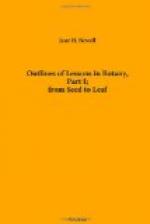[Illustration: FIG. 13.—Horsechestnut. I. Branch in winter state: a, leaf-scars; b, bud-scars; c, flower-scars. 2. An expanding leaf-bud. 3. Same, more advanced.]
The Bud Scale-Scars. These are rings left by the scales of the bud and may be seen in many branches. They are well seen in Horsechestnut. If the pupils have failed to observe that these rings show the position of former buds and mark the growth of successive years, this point must be brought out by skilful questioning. There is a difference in the color of the more recent shoots, and a pupil, when asked how much of his branch grew the preceding season, will be able to answer by observing the change in color. Make him see that this change corresponds with the rings, and he will understand how to tell every year’s growth. Then ask what would make the rings in a branch produced from one of his buds, and he can hardly fail to see that the scales would make them. When the scholars understand that the rings mark the year’s growth, they can count them and ascertain the age of each branch. The same should be done with each side-shoot. Usually the numbers will be found to agree; that is, all the buds will have the same number of rings between them and the cut end of the branch, but occasionally a bud will remain latent for one or several seasons and then begin its growth, in which case the numbers will not agree; the difference will be the number of years it remained latent. There are always many buds that are not developed. “The undeveloped buds do not necessarily perish, but are ready to be called into action in case the others are checked. When the stronger buds are destroyed, some that would else remain dormant develop in their stead, incited by the abundance of nourishment which the former would have monopolized. In this manner our trees are soon reclothed with verdure, after their tender foliage and branches have been killed by a late vernal frost, or consumed by insects. And buds which have remained latent for several years occasionally shoot forth into branches from the sides of old stems, especially in certain trees."[1]
[Footnote 1: Structural Botany, p. 48.]
The pupils can measure the distance between each set of rings on the main stem, to see on what years it grew best.
The Flower-Cluster Scars. These are the round, somewhat concave, scars, found terminating the stem where forking occurs, or seemingly in the axils of branches, on account of one of the forking branches growing more rapidly and stoutly than the other and thus taking the place of the main stem, so that this is apparently continued without interruption. If the pupils have not understood the cause of the flower-cluster scars, show them their position in shoots where they are plainly on the summit of the stem, and tell them to compare this with the arrangement of a large bud. The flower-cluster terminates the axis in the bud, and this scar terminates a branch.




